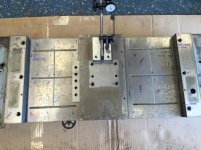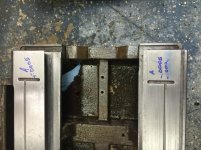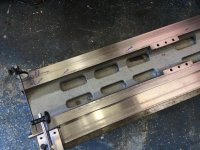pbrubaker
Aluminum
- Joined
- Sep 14, 2015
- Location
- Gaston, Oregon
Hey all,
I'm back with more of my Shizuoka VMC. I finally got the machine cleaned up, and took some measurements and photographs of the ways. Let me preface that this is my first rebuild (and definitely not the last,) I have spent a fair amount of time researching the subject, but I'm still a noob.
I could use some help assessing the condition of the slideways, and whether or not they need to be repaired. And also, if it doesn't require repair should I just go through with a grind/slideway material because I have it all apart, and there will be added benefits to using a bearing material.
Lets get to the meat. Here is a gallery of the shots I took during disassembly and cleaning. Coolant infiltration was a big problem that I intend to fix. There are many ways to improve the drainage and keep it off the machine.
Way Condition Gallery
Second, here are some detailed shots of each slideway and the corresponding measurements I took. Also I will list the things that are bothering me with each way and specific questions with regards to them.

Note: The En->En are parallelism measurements from edge to edge. A granite straight edge was clamped to one edge and a surface gauge was run along it's edge. The other 6 columns are surface variation from the front edge of the ways. Imagine you're looking top down on the ways.



I know the numbers don't look too bad, but there are some things I think I should deal with, but I welcome any and all opinions. I'm the type of person who usually bites the bullet and does things right the first time. And I've already put a lot of time and effort into this machine, so I'd really like to see it go back together as good as it possibly can.
That being said, I've only watched scraping videos, and I've never held a scraper. And I've read/watched as much as I could on slideway bearing material application, but there are some gaps there. How are the surfaces prepared? How much do I tell a grinder to take off? I'm a fast learner, and skilled with my hands, should I attempt learn scraping to scrape in the bearing material, or hire a pro? I know I'm getting a little ahead of myself here, but I just wanted to give you guys some of the questions I have.
I'm currently reading "Machine Tool Reconditioning" and "Testing Machine Tools" but both are slow going for me as they are a little dry for my tastes.
Anyway, I appreciate any guidance you care to provide, and I will update this thread as I progress along in this first rebuild.
Cheers,
Pete
Here's a link to the full photolog gallery and what I've been up to on this machine.
Shizuoka Millmaster B3-V Rebuild Gallery
I'm back with more of my Shizuoka VMC. I finally got the machine cleaned up, and took some measurements and photographs of the ways. Let me preface that this is my first rebuild (and definitely not the last,) I have spent a fair amount of time researching the subject, but I'm still a noob.
I could use some help assessing the condition of the slideways, and whether or not they need to be repaired. And also, if it doesn't require repair should I just go through with a grind/slideway material because I have it all apart, and there will be added benefits to using a bearing material.
Lets get to the meat. Here is a gallery of the shots I took during disassembly and cleaning. Coolant infiltration was a big problem that I intend to fix. There are many ways to improve the drainage and keep it off the machine.
Way Condition Gallery
Second, here are some detailed shots of each slideway and the corresponding measurements I took. Also I will list the things that are bothering me with each way and specific questions with regards to them.

| Bed Ways | Left Way | Right Way | |||||||||||
| E2->E1 | E1 | E2 | E3->E2 | E2->E3 | E3 | E4 | E3->E4 | Surface Variation | |||||
| 0.0001 | -0.0001 | -0.0003 | -0.0001 | -0.0001 | -0.0001 | -0.0002 | -0.0006 | -0.0002 | -0.0001 | Max | 0.0001 | 0 | |
| 0.0002 | 0 | -0.0004 | -0.0003 | 0.0001 | 0.0001 | -0.0003 | -0.0007 | -0.0003 | -0.0002 | Min | -0.0005 | -0.0007 | |
| 0.0001 | -0.0001 | -0.0004 | -0.0003 | 0.0001 | 0.0001 | -0.0004 | -0.0006 | -0.0003 | -0.0003 | Average | -0.000188889 | -0.0003 | |
| 0.0001 | -0.0001 | -0.0005 | -0.0003 | 0 | 0 | -0.0004 | -0.0006 | -0.0003 | -0.0003 | ||||
| 0.0001 | -0.0001 | -0.0004 | -0.0003 | 0 | 0 | -0.0003 | -0.0005 | -0.0002 | -0.0003 | Parallelism | |||
| 0 | 0 | -0.0003 | -0.0002 | -0.0002 | -0.0001 | -0.0003 | -0.0004 | -0.0002 | -0.0002 | Max | 0.0002 | ||
| 0 | -0.0002 | -0.0002 | -0.0002 | -0.0001 | -0.0002 | -0.0004 | -0.0002 | 0 | -0.0001 | Min | -0.0003 | ||
| 0 | -0.0002 | -0.0003 | 0.0001 | 0 | 0 | -0.0002 | -0.0003 | -0.0001 | 0 | Average | -0.00004 | ||
| 0 | 0 | 0.0001 | 0 | 0 | 0 | 0 | -0.0001 | 0 | 0 | (Datum) |
Note: The En->En are parallelism measurements from edge to edge. A granite straight edge was clamped to one edge and a surface gauge was run along it's edge. The other 6 columns are surface variation from the front edge of the ways. Imagine you're looking top down on the ways.
- The numbers here look great to me.
- Coolant got into the oil grooves, and corroded the top surface as it sat.
- The surface is pitted, I know this is not good, but just how bad is this?

| Saddle Ways (bottom) | Left Way | Right Way | ||||
| Surface variation | +/-.001 | +/-.002 |
| Surface Measurements | (with .010" gauge block) | ||||||
| Position (left to right) | 1 | 2 | 3 | 1 | 2 | 3 | |
| -0.0015 | -0.0005 | -0.0015 | -0.001 | -0.0005 | -0.001 | ||
| -0.0015 | -0.001 | -0.0015 | 0 | 0 | -0.0005 | ||
| -0.001 | -0.001 | 0 | 0.0005 | 0 | -0.0005 | ||
| -0.001 | -0.0015 | 0 | 0 | 0 | 0 | ||
| -0.0005 | -0.0005 | 0 | 0.0005 | 0.0005 | 0.001 | ||
| -0.001 | -0.0015 | 0 | 0 | 0 | 0 |
| Parallelism | ||
| Position (top to bottom) | E2->E1 | E2->E3 |
| 0.001 | 0.002 | |
| 0 | 0 | |
| 0.0005 | -0.0005 |
- I'm the most concerned with the saddle.
- The bottom surface doesn't look terrible but the relief in the middle of the saddle should probably be deeper.

| Saddle Ways (top) | Surface Variation | Dovetail Parallelism (per 6") | ||||
| Max | Min | |||||
| Dovetail 1 | -0.0005 | 0.0005 | ?? | Haven't made a King-Way yet… | ||
| Dovetail 2 | -0.002 | -0.0005 |
- These are definitely the worst of the bunch IMO.
- Coolant got into the oil grooves again, and swarf got under the table and grooved the way.
- I'm not a fan of oil grooves and scraping on the bottom surface, I'd rather have both on the top surface so things can be flushed out, rather than stay in. Wipers are more effective too. I think the condition of these ways makes the argument in favor of that practice.
- The surface is grooved pretty badly.
- Variances of about 0.002" (again measured with the granite straight edge as a parallel.)

| Surface Variation | Dovetail Parallelism (per 6") | ||||||||
| Table Ways | Max | Min | 1 | 2 | 3 | 4 | 5 | 6 (Datum Point) | |
| Dovetail 1 (top) | -0.0003 | -0.0001 | -0.0005 | -0.0005 | -0.0008 | -0.0007 | 0.0005 | 0 | |
| Dovetail 2 (bottom) | -0.0006 | -0.0003 |
- Given what the other side of this slideway looks like, I'm surprised the table's ways look so good. (I didn't check hardness.)
- These numbers are also better than I was expecting.
- I'd like to move the oil ports and grooves to this side of the way. And I'd like to consider bearing material for increased speed of this axis.
I know the numbers don't look too bad, but there are some things I think I should deal with, but I welcome any and all opinions. I'm the type of person who usually bites the bullet and does things right the first time. And I've already put a lot of time and effort into this machine, so I'd really like to see it go back together as good as it possibly can.
That being said, I've only watched scraping videos, and I've never held a scraper. And I've read/watched as much as I could on slideway bearing material application, but there are some gaps there. How are the surfaces prepared? How much do I tell a grinder to take off? I'm a fast learner, and skilled with my hands, should I attempt learn scraping to scrape in the bearing material, or hire a pro? I know I'm getting a little ahead of myself here, but I just wanted to give you guys some of the questions I have.
I'm currently reading "Machine Tool Reconditioning" and "Testing Machine Tools" but both are slow going for me as they are a little dry for my tastes.
Anyway, I appreciate any guidance you care to provide, and I will update this thread as I progress along in this first rebuild.
Cheers,
Pete
Here's a link to the full photolog gallery and what I've been up to on this machine.
Shizuoka Millmaster B3-V Rebuild Gallery



